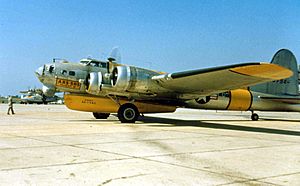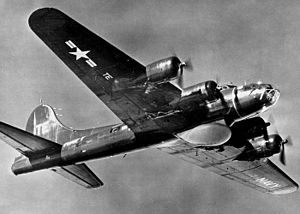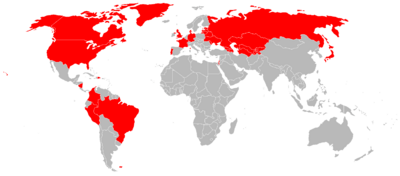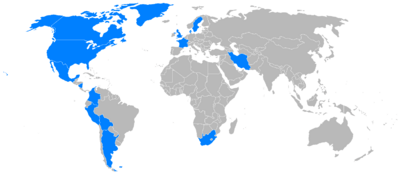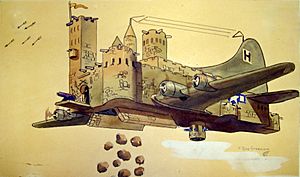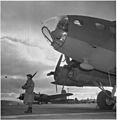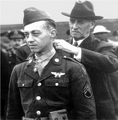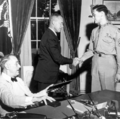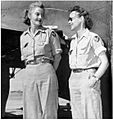Boeing B-17 Flying Fortress facts for kids
Quick facts for kids B-17 Flying Fortress |
|
|---|---|
 |
|
| A B-17G performing at the 2014 Chino Airshow | |
| Role | Heavy bomber |
| National origin | United States |
| Manufacturer | Boeing |
| First flight | 28 July 1935 |
| Introduction | April 1938 |
| Retired | 1968 (Brazilian Air Force) |
| Primary users | United States Army Air Forces Royal Air Force |
| Produced | 1936–1945 |
| Number built | 12,731 |
| Unit cost |
|
| Variants |
|
| Developed into | Boeing 307 Stratoliner |
The Boeing B-17 Flying Fortress was a powerful heavy bomber aircraft. It was used by the United States during World War II. This famous plane first flew in 1935 and joined the military in 1938. While it carried fewer bombs and couldn't fly as far as its partner, the B-24 Liberator, the B-17 had more guns to defend itself.
The B-17 dropped huge amounts of bombs during air raids, especially over Germany. It also played a role in the Pacific, like in the Battle of Midway. The B-17 earned its name, "Flying Fortress," because it was incredibly tough. It could keep flying even after taking heavy damage from enemy fire. Later in World War II, the U.S. added more escort fighters to protect these bombers, which helped them survive even more attacks.
The B-17 dropped more bombs than any other U.S. aircraft in World War II. Out of about 1.5 million tons of bombs dropped by U.S. planes on Nazi Germany and its occupied areas, over 640,000 tons (about 42.6%) came from B-17s. Besides bombing, the B-17 was also used for carrying supplies, hunting submarines, controlling drone planes, and searching for and rescuing people.
As of October 2019, nine B-17 aircraft can still fly, though none of them were used in actual combat. Many more are kept in storage or on display in museums. The oldest surviving B-17 that saw combat is a D-series plane called "The Swoose". It flew on the very first day the United States entered World War II.
Contents
How the B-17 Flew in War
The B-17 started flying missions in World War II with the Royal Air Force (RAF) in 1941. It also began operations in the Southwest Pacific with the U.S. Army.
Early Pacific Missions
A few weeks before the Japanese attack on Pearl Harbor, the 19th Bombardment Group sent B-17s to the Philippines. On December 8, 1941, half of these B-17s were destroyed on the ground. They were refueling and getting ready to attack Japanese airfields when the enemy struck. The remaining B-17s fought against the Japanese invasion force until they had to move to Australia.
In early 1942, more B-17s arrived in Java. A group of these B-17s went to the Middle East to fight the Germans. After a defeat in Java, the 19th Bombardment Group returned to Australia. They continued fighting there until mid-1942.
Joining the Fight in Europe
In July 1942, the first USAAF B-17s were sent to England to join the Eighth Air Force. Later that year, two more groups moved to Algeria to join the Twelfth Air Force for missions in North Africa.
The B-17s were mainly used for daylight strategic bombing missions. They attacked German targets like U-boat bases, docks, warehouses, airfields, and factories. During the campaign to weaken German air forces before the invasion of France, B-17 and B-24 raids targeted German aircraft production. This also drew German fighter planes into battles with Allied fighters.
During World War II, the B-17 was used by 32 combat groups overseas. In August 1944, there were 4,574 USAAF B-17s around the world. British heavy bombers, like the Avro Lancaster and Handley Page Halifax, dropped many tons of bombs as well.
After the War: New Roles for the B-17
After World War II ended, the B-17 was quickly taken out of service as a bomber. Most of the planes were flown back to the United States and sold for scrap. However, many B-17s were still used for other jobs. These included carrying VIPs (very important people), air-sea rescue, and taking photos from the air.
U.S. Air Force Uses
The Strategic Air Command (SAC), formed in 1946, used B-17s for reconnaissance (spying) until 1949. These planes were called F-9, and later RB-17.
The USAF Air Rescue Service used B-17s as "Dumbo" air-sea rescue aircraft. These planes carried special airborne lifeboats. This idea started in 1943, but they only began service in Europe in February 1945. They also helped with search and rescue for B-29 raids against Japan. About 130 B-17s were changed into air-sea rescue planes, first called B-17H and later SB-17G. Some SB-17s had their guns removed, while others kept them for use near combat zones. The SB-17 served through the Korean War and stayed in USAF service until the mid-1950s.
In 1946, extra B-17s were chosen to be drone aircraft. They were used for collecting air samples during the Operation Crossroads atomic bomb tests. This allowed them to fly close to or even through mushroom clouds without risking a crew. This led to more B-17s being turned into drones and drone control planes. They were used for more atomic tests and as targets for testing surface-to-air and air-to-air missiles. One hundred and seven B-17s were made into drones. The last time a B-17 flew a mission for the USAF was on August 6, 1959. A DB-17P plane controlled a QB-17G drone as a target for a missile.
During and shortly after World War II, the United States Navy (USN) got 48 B-17s for patrol and air-sea rescue. Thirty-two B-17Gs were used by the Navy as PB-1W aircraft. The "W" meant they were used for airborne early warning. They had a large radar dome under the fuselage and extra fuel tanks for longer flights. The B-17 was chosen partly for its many guns, but these were later removed. These PB-1Ws served until 1955.
In July 1945, 16 B-17s were given to the Coast Guard. They were called PB-1Gs starting in July 1946. Coast Guard PB-1Gs were based in different places in the U.S. and Newfoundland. They were mainly used for "Dumbo" air-sea rescue missions. They also helped with iceberg patrols and mapping. The Coast Guard PB-1Gs served through the 1950s, with the last one leaving service on October 14, 1959.
Special Operations Missions
B-17s were also used by CIA-linked companies like Civil Air Transport and Air America for secret missions. These included dropping agents over China from Taiwan. Four B-17s were shot down during these operations.
In 1957, the remaining B-17s were stripped of their weapons and painted black. One of these planes was used for a secret mission into Tibet. On May 28, 1962, a B-17 named N809Z flew a special mission called Operation Coldfeet. Two men parachuted from the B-17 onto an abandoned Soviet arctic ice station. They searched the station for several days. On June 1, the B-17 returned and picked them up using a special Fulton Skyhook system. This same B-17, N809Z, was later used to perform a Skyhook pickup in the 1965 James Bond movie Thunderball. This aircraft is now restored and is part of the Collings Foundation collection.
Countries That Used the B-17
The B-17 was a very useful aircraft. It served in many USAAF units during World War II. It was also used by the RAF for other purposes. Its main use was in Europe. There, its shorter range and smaller bomb load were not as much of a problem as they might have been in the Pacific. In August 1944, the USAAF had 4,574 B-17s worldwide.
Surviving B-17 Aircraft
Today, 46 complete B-17 planes still exist. Nine of these can still fly. 39 of the surviving planes are in the United States.
The B-17 as a Symbol
The B-17 Flying Fortress became a symbol of American air power. In 1943, a survey showed that 90% of people knew about the B-17. This was much higher than the 73% who knew about the B-24.
Early B-17s were used to show off their long range. In January 1938, Colonel Robert Olds flew a B-17 from the U.S. east coast to the west coast. He set a record of 13 hours and 27 minutes. He also broke the west-to-east record, averaging 245 miles per hour. Six B-17s flew a goodwill mission to Buenos Aires, Argentina, in February 1938. They covered 12,000 miles. On May 12 of the same year, three B-17s "intercepted" and photographed the Italian ocean liner SS Rex 610 miles off the Atlantic coast.
Many pilots who flew both the B-17 and the B-24 preferred the B-17. They found it more stable and easier to fly in formation. The B-17's electrical systems were also less likely to be damaged than the B-24's hydraulic systems. It was also easier to fly a B-17 with a missing engine than a B-24.
During the war, the largest bombing force, the Eighth Air Force, preferred the B-17. General Jimmy Doolittle wanted the Eighth Air Force to use B-17s. He said it was easier to manage fewer types of aircraft for maintenance and spare parts. Studies showed that the B-17 was more useful and could survive better than the B-24 Liberator. The B-17's toughness became legendary. Many stories and photos showed B-17s returning to base even after being heavily damaged in battle.
B-17 Technical Details
| Data | Units |
|---|---|
| Years of production | 1935-1945 |
| Manufacturer | Boeing |
| Wingspan | 31.62 meters |
| Length | 22.66 meters |
| Hight | 5.82 meters |
| Wing area | 131.92 m² |
| Wight (empty) | 16,391 kg |
| Max takeoff weight | 29,710 kg |
| Crew | 9 |
| Speed | 462 km/h |
| Service ceiling | 10,800 meters |
| Range | 3,220 km |
| Powerplant | 4x Wright-R-1820-97 Cyclone |
| Power | 4x 895 kW (1,217 HP) |
| Weapons | Up to 8 tons of bombs and 13x 12.7mm machine guns |
Famous B-17s
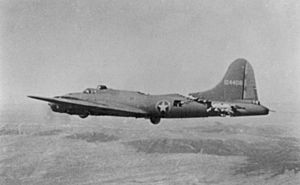
- All American – This B-17F survived even after its tail was almost cut off! This happened in a mid-air crash with a German fighter over Tunisia. It still returned safely to its base.
- Hell's Kitchen – This B-17F was one of only three early B-17Fs to complete over 100 combat missions.
- Mary Ann – A B-17D that arrived in Hawaii during the attack on Pearl Harbor. It became famous after its story was told in the 1943 movie Air Force.
- Memphis Belle – One of the first B-17s to complete 25 missions. It was the subject of a movie and is now fully restored. You can see it on display at the National Museum of the United States Air Force.
- Miss Every Morning Fix'n – A B-17C that crashed in Australia in 1943. 40 of the 41 people on board died, making it the worst air disaster in Australian history.
- Murder Inc. – This B-17 was used in German propaganda newspapers.
- Old 666 – A B-17E flown by the most decorated crew in the Pacific.
- Royal Flush – This B-17F was the only B-17 from its group to return from a tough raid on Münster, Germany, in October 1943.
- The Swoose – This is the only complete B-17D still existing. Built in 1940, it is the oldest surviving Flying Fortress. It is also the only B-17 that saw action in the Philippines campaign (1941–1942). It is being restored for display at the National Museum of the United States Air Force.
- Ye Olde Pub – This B-17 was famously not shot down by a German pilot named Franz Stigler. Their story is remembered in the painting A Higher Call.
- 5 Grand – This was the 5,000th B-17 ever made. It had the signatures of Boeing employees on it. It served in Europe and later went on a tour to promote war bonds.
Images for kids
-
Installation of fixtures and assemblies on a tail fuselage section of a B-17 at the Douglas plant in Long Beach, California, October 1942
-
B-17Bs at March Field, California, prior to attack on Pearl Harbor, with framed nose glazing of the style retained through the B-17E model
-
Nose of a B-17G being restored at the Mighty Eighth Air Force Museum
-
B-17F formation over Schweinfurt, Germany, 17 August 1943
-
Formation flying through dense flak over Merseburg, Germany
-
Captured B-17F-27-BO in Luftwaffe markings, the USAAF-named "Wulfe-Hound", 41-24585, of the 360th BS/303rd BG, was downed on 12 December 1942 near Leeuwarden, Netherlands, while on a raid on Rouen, France. The first Flying Fortress to fall intact into German hands, it was operated by Kampfgeschwader 200 from March 1944.
-
Maynard H. Smith receiving Medal of Honor from Secretary of War Henry L. Stimson
-
L–R, Nancy Love, pilot and Betty (Huyler) Gillies, co-pilot, the first women to fly the Boeing B-17 Flying Fortress heavy bomber for the WASP
See also
 In Spanish: Boeing B-17 Flying Fortress para niños
In Spanish: Boeing B-17 Flying Fortress para niños



